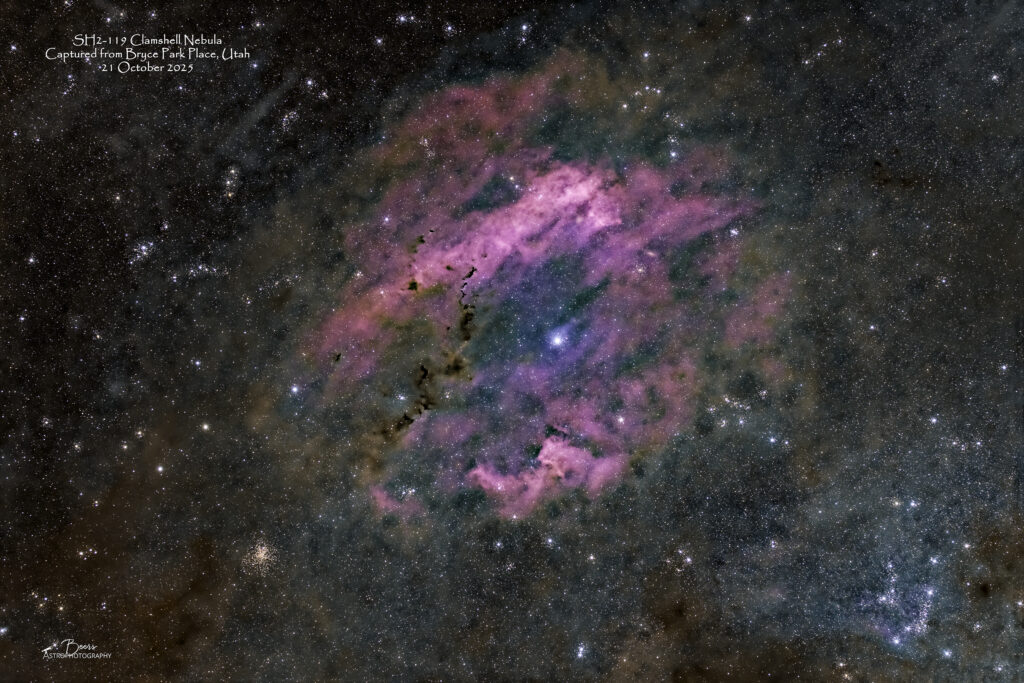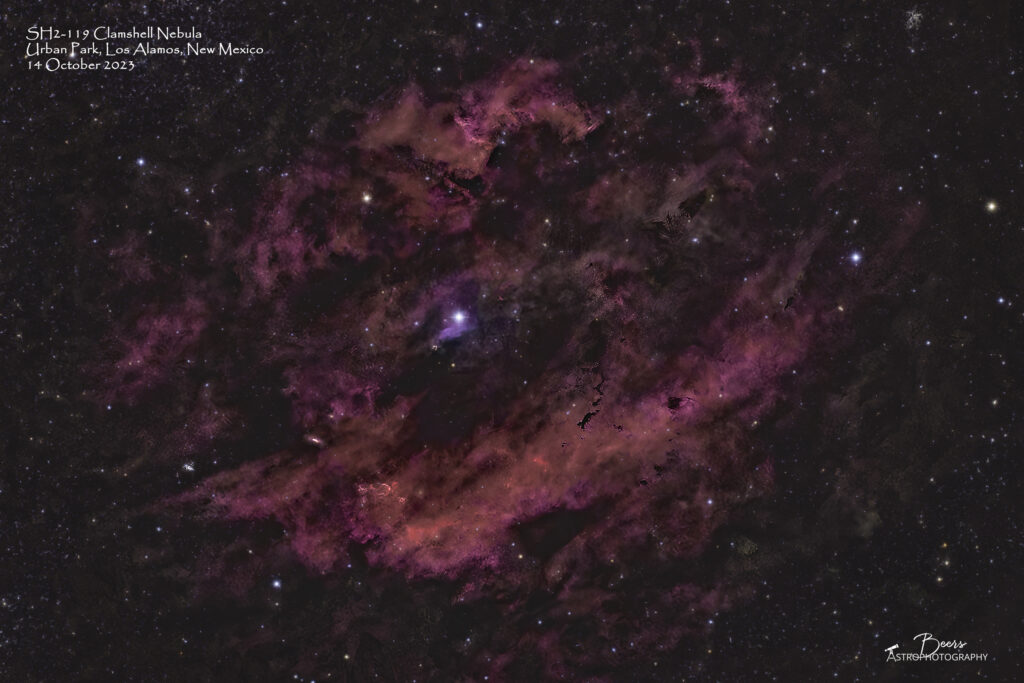
Fun facts
Sharpless 119, is a large patch of emission nebulosity in the constellation Cygnus some 2300 light years from Earth. It’s only 2-3 degrees away from the North American and Pelican Nebulae, so is often overlooked. The bright star 68 Cygni, at a magnitude 5, is one of the stars responsible for ionizing the surrounding gas. The nebulosity appears to envelope the star 68 Cygni, with its shape appearing similar to two shells that are arranged to the east and west of the star. In the southern part, thin filaments and cocoons of dark nebulae are visible, which contrast strongly both with the light of the nebula and with the rich background star field. Riddled throughout this complex are several brighter emission patches and dark nebulae with their own LBN and LDN designations.
- Other Catalog Designations: LBN391
- Subtype: HII region
- Distance from Earth: 2300 light years
- Apparent Size: 2°30’ x 1°
- Apparent magnitude: 4.2
- Constellation: Cygnus
{Target information from https://it.wikipedia.org/wiki/Sh2-119 , https://telescope.live/gallery/sh2-119-clamshell-nebula-1 and Stellarium}
Capture & Processing Notes
Capture Notes: During the day on Tuesday (our last day of the Utah 65th Birthday trip), I got the bright (okay maybe not so bright) idea to image the SH2-129 Flying Bat/Giant Squid with my new ZWO ASI6200MM mono camera and the OIII filter that I’d brought with me. Although the filter wheel was still not assembled, the drivers had not been loaded, and I hadn’t tested out how it operates – I could use the camera with the OIII filter attached directly in imaging stream (or so I thought).
We got back to Bryce Park Place, at about 14:30MDT, after touring through Bryce Canyon National Park and having a late lunch at the Route 12 Grill. I started to disassemble the OSC camera and 0.7x reducer to replace the camera with the mono camera and install the filter into the reducer. I got all the mechanical connections made and the camera reassembled…then tried to calculate the correct exposure settings for the flat frames (and capture all the calibration frames to save time in the morning when we were going to be packing up to leave) – in the bright sunlight at about 16:00MDT. Not a good idea! I couldn’t see the laptop screen and I couldn’t tell if the light pad was on or off! I finally gave up after about 30 minutes of struggling when I started getting error messages on the camera connection and found that it was only downloading about half of the images in the calibration frame sequence. At least I was smart enough, at that point, to realize this wasn’t a good idea to spend valuable dark skies time with this “untested” equipment (…apply your OT&E experience before taking the new equipment into “combat” Suzanne!!).
So, I disassembled the mono camera and the 0.7x reducer (taking the OIII filter back out of its imaging train) and reassembled the Southern Cross with the OSC camera and 0.7x reducer…and made a plan to image SH2-119 Clamshell Nebula when I determined with a quick search of my website that I didn’t have SH2-119 in the gallery and a further search of my journals on the portable hard drive I carry confirmed that I’d never imaged it under dark skies. Both of those “research” results were wrong, further highlighting that I really do need to build that database – so all my data collection, journaling, planning, captured image, training, etc. information is all in one place!
I got everything ready to go with enough time to take Zeus for a walk before it was dark enough to get the sequence started. When I did – I found that the autofocus #1 was way out of focus. That gave me a little pause wondering if I’d truly assembled the OSC camera and 0.7x reducer back together correctly. I accomplished a manual focus, which ended up being close to focus at position 4386 (hmmm, the focus position the previous night was 5338…). I went with my new position (with a hope and a prayer that I hadn’t broken or severely messed things up in my assemble/disassemble/reassemble frenzy) and started the SGP sequence. It ran through AF#1 (position 4335, HFR 2.3, 96% curve fit), plate solve (my camera rotation angle was off by 5.1° – of course, I have the tolerance set for 5°), I rotated the camera (counterintuitively LEFT is CW) to a delta of 1.7°; autoguider calibrated with no errors (confirming, at least in my mind, that the polar alignment delta in declination caused the errors I was receiving the previous night); AF#2 (position 4327, HFR 2.2, 96% curve fit); and started the sequence at 19:55MDT
I came back out at 20:56 to conduct the meridian flip (after a whopping 45 minutes of “sleep”). Disconnected all the equipment, disconnect/reconnect AG control cable, and restarted the SGP sequence. Immediately received an error message – “Sequence error – currently in use elsewhere.” What in the world does that mean?? Apparently SGP didn’t know either because it continued on with the sequence start up routine. Again I got the “Large RA/Dec error” warning – this time I assumed it was because it was so close to the meridian. AF resolved at position 4284, HFR 2.3, 95% curve fit with an error message that the HFR was larger than expected.
Despite all the warnings to the contrary, the sequence started at 21:02 capturing frame #12 where it had left off before the meridian flip…apparently without issue. The sequence was scheduled to run until 03:14MDT when SH2-119 would set below 20° and I would switch to M31 Andromeda for the rest of the dark hours before I would shut down to begin packing up the equipment for our trip home.
I was marginally nervous about letting the sequence run for 6+ hours, but my experience in getting up, dressed, and going out to check progress mid-sequence has never been timed very well (e.g., I check it and the sequence aborts 20 minutes later or I check it and it aborted 2 hours ago). So really there’s no telling if/when you should check progress – so every time I woke up and looked at my watch, finding I still had time before the scheduled shut-down, I rolled over and went back to sleep.
Of course, it turns out that the sequence aborted at ~02:00MDT – so when I got up at 03:15 and went outside to shut it down, I’d lost over an hour of data capture. Although I haven’t combed through the SGP logs yet, there were no error messages in the SGP notification panel. PHD2 had an error message that there was an issue with its ASCOM driver and its logging showed a lost star. So, time with the logs will tell what really happened (but that may not happen for a while; with the need to start on Christmas cards, calendars, etc. as the next things on my to-do list).
At 03:30MDT I started the M31 Andromeda sequence – and it collected successfully until I terminated it at ~06:00 to pack up the equipment to go home.
Sequence plan: Gain 158, Offset 30, Temp 0°C; 66x5min. Captured 21Oct2025, 19:55MDT – 22Oct2025, 02:04MDT
Processing: Captured in SGP, stacked in APP (Adaptive Airy Disc), star removal with Starnet++, processing with LR/PS (using my new adjustment to Bill Banshan’s star removal process to decrease the “rich star field” of the Cygnus Star Cloud)
Equipment
All equipment controlled by HP Probook (DSO-CTRL1) running Sequence Generator Pro v4.4.1.1441.
- Polar alignment: QHYCCD camera (controlled by Polemaster for polar alignment)
- Imaging (ASI2400-SC with 0.7x Reducer): ZWO ASI2400MC imaging camera; (Southern Cross) Askar FRA600 108mm f/5.6 Quintuplet Petzval Flat-Field Astrograph with Askar 0.7x Reducer for Askar FRA600 108mm Astrograph
- Mount: Rainbow Astro RST-135E (controlled by iHubo ASCOM driver)
- Autoguiding: Orion 60mm Multi-Use Guide Scope with Orion StarShoot AutoGuider Pro Mono Astrophotography Camera (controlled by PHD2)
- Auto Focuser: ZWO EAF Electronic Automatic Focuser – Standard (New 5V Version) (EAF-5V-STD)
Summary
Sequence plan: Gain 158, Offset 30, Temp 0°C; 66x5min. Captured 21Oct2025, 19:55MDT – 22Oct2025, 02:04MDT
Shooting Location: Bryce Park Place, Cannonville, Utah
Processing: Captured in SGP, stacked in APP (Adaptive Airy Disc), star removal with Starnet++, processing with LR/PS (using my new adjustment to Bill Banshan’s star removal process to decrease the “rich star field” of the Cygnus Star Cloud)
Other images of SH2-119 Clamshell Nebula

Capture & Processing Notes
Capture Notes: Our “dark skies” trip for October was in conjunction with the trip for the annular solar eclipse. We originally planned to get a campsite at Chaco Canyon to watch the eclipse from there, but were defeated by the NPS campsite reservation system. So, settled on Los Alamos as a spot within the path of maximum eclipse (knowing that trying to get a hotel room in Albuquerque during the second weekend of Balloon Fiesta would be as fruitless as our attempts at a Chaco Canyon campsite). Paul found the North Road Inn for our accommodations, which turned out to be perfect! It was caddy corner across the street from Urban Park where we set up for the eclipse and for DSO imaging (after confirming with a local that we met during the eclipse, that my equipment would be safe on its own while I went back to the room. He said, “This is Los Alamos, other than the bears, no one will bother it”).
We arrived in Los Alamos on Thursday, 12 October. The night was clear, but I was too tired from the travel, it was dark after we finished a birthday celebration without any setup accomplished, and when Jan and I walked down to the park to check it out we found it to be eye-wateringly windy and cold. So, I decided not to image. Friday night was forecast to be cloudy. Although Dave reminded me of my Milky Way imaging advice to him when they were in Sooke, BC, saying “Don’t believe the forecast, set up so you’re ready for when it’s wrong.” I failed to heed that sage advice – going to bed with and waking up to clear skies – ARGH!
So, on Saturday, come hell or high water, I was going to image! Before it got dark, Dave helped me set up in Urban Park. We got the sequence for this image started and went back into the Inn for pizza. I planned to (and did) split the night between the Clamshell Nebula and capturing some data on the Witch Head when it rose after midnight. In hindsight, I should have spent more time on Clamshell, as the capture of Witch Head was aborted at about 0300 (that I didn’t discover until I came out at about 0430 for the meridian flip) losing over 90 minutes of imaging time. There were no clouds, so I’m suspecting an east-of-the meridian issue that wouldn’t have happened with Clamshell. Ah well, image and learn…and the data collected on Witch Head will not go to waste.
Sequence plan: Gain: 158, Temp: -0°C, offset=30; 56x5min; Total exposure time: 5:30hrs. Captured 14 October 2023 (14Oct23, 19:44MDT – 15Oct23, 01:01MDT)
Processing: Captured in SGP, stacked in APP, star removal with Starnet++, processing with LR/PS (including star reduction of the overwhelmingly “rich star field”)
Equipment
Equipment controlled by HP Probook (DSO CTRL 1) running Sequence Generator Pro v3.2.0.660.
- Polar alignment: QHYCCD camera (controlled by Polemaster)
- Imaging stream: (Southern Cross) Askar FRA600 on Rainbow Astro RC-135E, ZWO ASI2400MC#1 camera
- Mount: Rainbow Astro RC-135E (controlled by iHubo ASCOM driver)
- Autoguider: Orion 60mm Multi-Use Guide Scope, Orion StarShoot AutoGuider Pro Mono Astrophotography Camera (controlled by PHD2)
Summary
Sequence plan: Gain: 158, Temp: -0°C, offset=30; 56x5min; Total exposure time: 5:30hrs.
Captured: 14 October 2023 (14Oct23, 19:44MDT – 15Oct23, 01:01MDT);
Shooting location: Urban Park, Los Alamos, New Mexico
Processing: Captured in SGP, stacked in APP, star removal with Starnet++, processing with LR/PS (including star reduction of the overwhelmingly “rich star field”)
